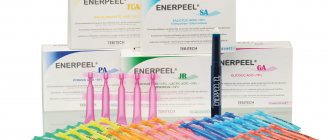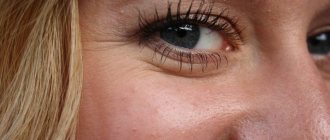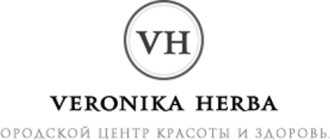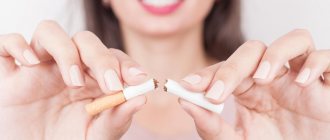What is almond peeling?
Peeling based on mandelic acid affects only the stratum corneum, so it has gained the reputation of the most gentle and delicate chemical peeling. Its effective effect on the skin is due to the mandelic, or hydroxy-phenylglycolic acid, which is a fruit acid. It is contained in almond kernels and is a natural natural product. In concentrated form, this acid can cause chemical burns, but in diluted form, intended for cosmetic purposes, it is not toxic.
Preparation
The first thing you need to start preparing for peeling is an allergic reaction test. To do this, apply a drop of acid to the crook of your elbow. If there is no burn, itching or other unpleasant symptoms, you can safely begin preparation.
Pre-peeling preparation
The duration of this stage is from 1 to 2 weeks and consists of gradual adaptation of the skin to the effects of mandelic acid. In this way, the risks of unwanted effects are minimized, and the dermis becomes more susceptible to peeling.
During the entire preparation period, it is necessary to apply a cream containing mandelic acid from 5% to 15% to the skin before going to bed, depending on the type and sensitivity of the skin.
Use a light exfoliation gel based on fruit acids a couple of times a week. Again, in product lines from the same brand you can find a gel based on the same mandelic acid. It is important not to use cream these days.
In the case of home peeling, pre-preparation should never be neglected. Unfortunately, it is very difficult to avoid the negative consequences of a chemical skin burn on your own. Even experienced cosmetologists will not always agree to do almond peeling without this stage.
What is the effect of almond peeling?
Almond peeling has several pronounced effects. The exfoliating effect occurs due to the destruction of the bonds between the scales of dead cells of the upper layer of the epidermis. This effect allows the skin to speed up the process of formation of new cells, removing old scales from the surface.
The effect of getting rid of comedones (blackheads) is associated with their dissolution when acid enters and cleansing the mouths of the sebaceous ducts.
Almond peeling is a great way to get rid of pimples, since the antiseptic properties of phenylglycolic acid perfectly counteract the bacteria that cause acne.
The action of almond peeling is limited to the level of the epidermis, which is explained by the rather large size of the molecules that cannot penetrate into the deeper layers of the skin.
Peeling based on mandelic acid lightens age spots well solely due to the removal of the stratum corneum of the skin, and not by affecting the cells responsible for the formation of melanin (melanocytes).
As the gentlest of chemical peels, it is suitable for thin and sensitive skin: large molecules slowly penetrate the epidermis without irritating the skin.
Evening out skin tone, getting rid of wrinkles and reducing pores after almond peeling occurs due to the reduction of the epidermis layer, and skin renewal occurs due to more active formation of collagen and elastin fibers.
Step-by-step instruction
- 1. Cleanse the skin.
Using lotion, remove cosmetics from your face; if you have cosmetic milk with mandelic acid, complete the cleansing procedure by wiping your facial skin with it.
- 2. Steam the skin.
Cover your face with a damp, warm cloth. As a result, the pores will open and the acid molecules will penetrate deeper into the epidermis layer.
- 3. Tone the skin.
To tone and disinfect the surface of the skin, treat it with tonic with 10% mandelic acid.
- 4. Pre-peeling.
Treat the skin around the eyes, nostrils, lips and eyebrows with Vaseline (to protect the skin and pigment from the acid solution). Prepare skin for acid application with a low percentage formulation of 5% mandelic, lactic and glycolic acids.
- 5. Peeling.
Rules for applying almond peeling
Without washing off the pre-peeling layer, apply the acid evenly to the face with a brush, avoiding the areas around the eyes. Keep for 1 to 15 minutes. Usually the duration is specified by the manufacturer, it depends on the type, color, degree of sensitivity of the skin and existing problems. Be sure to follow the instructions and watch the timer!
The acid concentration should be selected based on the task assigned to the peeling:
- to cleanse sensitive skin and for the first independent experience, stop at 10% acid;
- for light peeling and slight lightening of pigments, drying out acne, choose 15% mandelic acid;
- for experienced girls who want to eliminate serious skin defects, 20% is suitable.
We do not recommend making peeling mixtures yourself. This means adding other fruit acids, such as citric acid, to enhance the whitening effect. This is the prerogative of specialists and is available in every good beauty salon. At home, work with what the drug developers have prepared for you.
- 6. Neutralize the acid. Wipe your face with a cotton pad soaked in a solution of fruit acid neutralizer. You can cook it yourself. To do this, mix boiled water and soda in a ratio of 1:4. There may be a slight burning sensation. This soda neutralizes the acid. Rinse thoroughly with warm water.
- 7. Moisturize the skin.
Finally, apply a soothing mask to your skin. You can make it yourself using chamomile decoction and aloe pulp, or use a care product from the manufacturer of mandelic acid.
The main rule of home peeling is not to overdo it. Neither with time, nor with the number of layers of acid applied.
Indications
Peeling based on mandelic acid is used for patients with problem skin, increased oiliness, or skin prone to rashes and acne formation. It is recommended as a preliminary procedure for deeper medium peeling or laser resurfacing. If a cosmetic procedure is planned involving the use of products that penetrate deeply into the skin (vitamins, microelements), then almond peeling is also a preparatory step. This procedure is prescribed for uneven skin, acne marks, scars, scars.
Almond peeling is used not only to improve the condition of facial skin during photoaging, it is prescribed to treat aging skin of the hands and décolleté. For seborrhea, rosacea, rosacea and hyperkeratosis, it has a well-defined effect. This gentle peeling is also prescribed for sensitive and hypersensitive skin.
There is a seasonal feature of the use of almond peeling. If the skin has problems with pigmentation, and the patient has recently undergone treatment for it, or if the skin is susceptible to the formation of age spots, then the procedure should be carried out in the autumn-winter months - from October to March. Healthy skin without a tendency to pigmentation has no contraindications for the procedure in the spring and summer.
Varieties
The versatility of the components of mandelic acid allows you to combine them with other drugs and acids. This is how a combined facial cleansing is performed, which gives a complex effect on the skin.
Almond milk peeling
Lactic acid gently treats the surface; it is added for moisturizing and softening effects. When used independently, it is ineffective; it is used for pre-peeling or in combination with other acids. Combination with phenylglycolic acid will give an amazing effect: the structure of the skin will be changed, but its surface will retain a moisturized, well-groomed appearance.
Almond-apple peeling
Another acid that goes well with almond acid is malic acid. It is rich in amino acids that fight rosacea and remove acne. Peeling may begin after a few days, at which time skin hydration increases (its deep hydration). The session lasts about an hour, the structure is enriched with vitamins and minerals.
Almond-salicylic peeling
This is a more severe option; due to the aggressive effects of salicylic acid, the proportions must be precisely controlled and applied carefully. It removes bumps and makes the skin smooth. The color should also be equal: age spots and redness will go away.
On our website facesave.ru you can read about yellow retinol facial peeling in this article.
How is the procedure performed?
The procedure takes on average about an hour. The first step is to gently cleanse your face of makeup and impurities. Next, the surface of the skin is treated with a degreasing agent. A protective cream is applied to such delicate parts of the face as the corners of the lips, the area around the eyes, the transition from the mucous membrane on the lips and around the nose to prevent burns to these sensitive areas. The next step is to apply a preparation containing a reduced amount of mandelic acid, only 5%. This step is necessary to test the skin's reaction to the acid. If the reaction is normal, the next layer is applied with a normal 30% solution of mandelic acid. A light massage is performed on it. Then the peeling preparation is washed off first with a neutralizing solution and then with plenty of water. After removing the solution, apply a soothing mask for 20 minutes. The next step is to apply moisturizer.
Before the procedure, the patient is recommended to undergo special skin preparation. It consists of using products containing mandelic acid two weeks before peeling. This way the skin gets used to the drug and absorbs it better during the procedure.
What medications are needed for the procedure?
Today, the easiest way to carry out almond peeling at home yourself is to purchase ready-made kits for this manipulation.
Such kits include special products for cleansing the skin before acid exposure, the acid itself and skin care after peeling, as well as detailed instructions for correctly performing the procedure.
Or you can buy mandelic acid of the required concentration at a pharmacy or professional beauty salon and use it along with your usual cleansing and post-care products. However, it is safer to trust the professionals and opt for a line of products from one manufacturer.
Post-procedure care
On the day of the procedure, you should not expose your skin to sudden temperature changes, and visiting a bathhouse, sauna, or swimming pool will have to be postponed. Even regular chlorinated water can be harmful. Therefore, washing should be done with products recommended by a doctor. The day after the procedure, the skin may be dry, tight, and even begin to peel. It is important to regularly use the products prescribed by your doctor, and the peeling and dryness will go away in a couple of days. Under no circumstances should you use abrasive peeling to get rid of peeling; this can damage the delicate top layer of skin, leading to the formation of scars and scars. In addition to creams recommended by your doctor, you can make moisturizing masks or apply moisturizing creams with collagen and hyaluronic acid. Before going outside for three weeks, be sure to use a cream with a high sun protection factor - 50 SPF or higher.
Compliance with these recommendations is the final and supporting stage of the procedure.
Why does the skin peel after peeling and what to do about it?
2-3 days after the procedure, you will see scales on the surface and this is quite normal. The lower the pH level of the product you used, the more severe this problem will be.
What to do with them during this period in order to quickly return to duty?
- Intensively use moisturizing and restoring creams with urea, glycerin, vitamin E, hyaluronic acid. Soothing healing pharmaceutical products based on bisabolol and panthenol will also help;
- Gently cleanse the skin without using brushes, sponges, or scrubs. She should recover by the next session, so she cannot be injured;
- The scales on the surface should come off on their own; they cannot be torn off, otherwise wounds and crusts will form;
- It is better to wash your face with mineral water, completely avoiding contact with chlorinated water;
- Apply sunscreen with SPF 50 protection.
Peeling should go away in about 3 days.
Contraindications
The procedure is not recommended in the presence of severe autoimmune diseases, during pregnancy and lactation. The presence of injuries, skin damage, as well as exacerbation of herpes are contraindications for the procedure. It does not apply if the patient has recently returned from a resort and has a fresh tan, or in cases of an allergic reaction to mandelic acid preparations.
Results, before and after photos
Remember that you can maintain healthy and youthful skin without the help of cosmetologists. The main thing is to take good care of her and not experiment with her.
Almond peeling results
Treatment is recommended to be carried out in courses of 6-10 procedures with weekly breaks. If during the course the patient regularly takes vitamins A, C and E, the skin will recover much faster and its immunity will strengthen.
After almond peeling, the skin brightens, pigment spots disappear, the skin is evened out and becomes radiant. Small wrinkles are smoothed out, and large ones are reduced. The skin structure becomes dense and uniform. Peeling based on mandelic acid makes the skin visually younger, healthier, smoother and more beautiful.
Properties and production of mandelic acid
Mandelic acid is extracted by hydrolysis from bitter almond extract containing the glycoside amygdalin. It belongs to the group of fruit acids. The molecules of amygdalic acid are relatively large, so they gently cleanse the skin without damage or allergic reactions. In nature, almond acid (amygdalic acid or phenoxyglycolic acid) binds to disaccharides found in fruit seeds, so it is excellent for peeling. The acid has an antimicrobial effect and a protective function against dry skin, hair and nails.
Recovery period: how to care
Not only the technology is important, but also care after exfoliation (deep cleansing of the skin). This will restore it and give the rejuvenated particles the opportunity to express themselves to the maximum. We need to help them with the right actions during care. You need to take extra care of such areas for 4 days. Washing with acidic water is suitable; this will ensure a smooth, gentle transition to a normal alkaline environment.
Moisturizing creams should nourish the epidermis and restore its protective functions. Pay special attention to the sun: you need to avoid tanning and use products with UV protectors. This will reduce the risk of getting burned to a minimum. And if after the procedure strange redness or rashes appear, it is better not to hesitate and consult a doctor.
Cost of sessions
As with other self-care activities, doing almond peeling is quite expensive. Its price depends on the location, choice of products, and the assistance of a beauty clinic employee. The cost in the salon is much higher than at home: one visit costs about 6,000 rubles, and you often have to pay extra for the preparatory stage, various creams, masks. But an experienced specialist gives a guarantee and monitors the condition of the skin. Moreover, you can get a discount for paying for the entire course at once.
You can do it at home cheaper, the main thing is to choose the right product. If you want to save money, you can buy proven drugs on the Internet, but only if the supplier is trusted and provides certificates. Then the price will drop by almost 2 times, and you won’t have to pay for the work. In addition, it is difficult to find products on sale that can cause significant harm: they are all gentle and suitable for home use.
Reviews from cosmetologists
Experts emphasize that such peeling does not injure the skin as much as glycolic peeling. But they insist that it is better to entrust the procedure to professionals or with proven drugs. Otherwise, improper almond facial peeling at home can lead to burns, increased peeling, and other side effects. But if the procedure is carried out correctly, all cosmetologists agree: it is effective, beneficial for the skin of the face, and makes the appearance fresh and attractive.
Interesting: 5 healthy habits that will help improve skin condition











